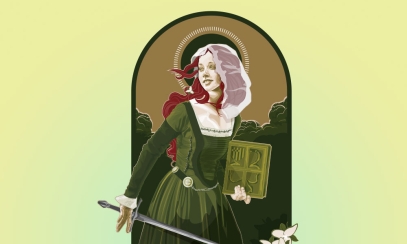
St. Abraham Kidunaia: The Runaway Groom
Julia Roberts had a big hit with the movie Runaway Bride. If a movie were made about the life of St. Abraham Kidunaia, it might be called Runaway Groom.
St. Abraham, whose feast day is March 16, lived in the sixth century near the Syrian city of Edessa, in modern-day Turkey. Abraham’s wealthy parents chose a bride for him, according to Syrian custom. There was only one problem: Abraham had privately vowed to live a celibate life, but he hadn’t let his family in on his plans. He didn’t want to disobey them, but he didn’t want to get married, either.
He joined in the week of partying and feasting that led up to his wedding, but when the big day came, Abraham bolted from the wedding. He ran into the desert, where he walled himself up in a cave, leaving only a small hole for food and messages.
This wasn’t quite as odd as it sounds to our modern ears. The sixth century was right in the middle of the golden age of hermits, when many people (including several who became saints) chose to witness their faith by holy solitude. Abraham’s family and friends tried to get him to come out of the cell in his cave, but he refused. Finally, they agreed to call off the wedding and leave him in peace.
Abraham led his hermit life for 10 years, until the local bishop called upon him to help convert the town of Beth-Kiduna, which persisted in paganism and idol worship despite the bishop’s best efforts. Abraham didn’t want to do it, but was obedient to the bishop who ordained him a priest and sent him on his way.
The people of Beth-Kiduna were not happy to see Abraham. First, he tried to talk to them, but they refused his call to baptism. Then, he built a church, came back into town, and destroyed their idols and pagan altars. That really made them angry. So they whipped St. Abraham and dragged him out of town.
He was back the next day, preaching in the village square. They threw him outside the village walls, stoned him, and left him for dead. But he was back again the following day. For three years, Abraham continued to preach, and the people continued to hurl rocks and insults at him. (Makes you wonder if he wouldn’t have been better off getting married.)
Eventually, Abraham’s holiness and persistence paid off, and he baptized 1,000 of Beth-Kiduna’s citizens. He stayed with them another year, teaching them the faith and baptizing still more people. He prayed for another priest to come and take care of the people. And when the bishop sent one, Abraham returned to his cell, where he remained in prayer and solitude until the age of 70.
Despite living as a hermit, he won the love and admiration of the surrounding communities, and many people flocked to his cave to receive his blessing during his last days. His final trip out of his cell was for his funeral which was attended by many mourners. Many of them took bits of his goatskin tunic and cloaks as relics of the saint. St. Abraham showed others that even though someone might be walled up in a cave, he can still make a difference to others.



